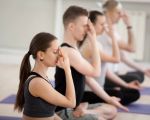Yoga for Improving Muscle Recovery After Workouts: A Comprehensive Guide
- 1. The Role of Yoga in Muscle Recovery
- 2. How Yoga Enhances Flexibility and Reduces Muscle Tension
- 3. Best Yoga Poses for Muscle Recovery
- 4. Tips for Integrating Yoga into Your Post-Workout Routine
- 5. Real-Life Benefits: Success Stories from Athletes
1. The Role of Yoga in Muscle Recovery
After a tough workout, your muscles are often fatigued and in need of recovery. While many people turn to stretching or foam rolling, yoga can also be an incredibly effective way to promote muscle recovery. Yoga helps release muscle tension, improve flexibility, and increase blood circulation, all of which are essential for muscle recovery after workouts.
Yoga works by engaging the muscles in controlled stretches and poses that encourage the release of lactic acid, a byproduct of intense physical activity. By performing yoga after exercise, you not only aid in recovery but also help to reduce the risk of injury, alleviate soreness, and prevent stiffness. It’s a holistic practice that can complement your workout routine and help you recover faster and more efficiently.
2. How Yoga Enhances Flexibility and Reduces Muscle Tension
One of the primary benefits of yoga is its ability to improve flexibility, which plays a key role in muscle recovery. Many workout routines, especially those focused on strength training or intense cardio, can lead to tight, shortened muscles. Over time, this can reduce your range of motion and lead to imbalances that may contribute to injury.
Yoga helps by gently stretching the muscles, improving their length and elasticity. It allows the muscles to relax and release any tension built up during the workout, which is crucial for recovery. Regular yoga practice also promotes better posture, alignment, and balance, which can further reduce muscle strain and help your body recover properly.
By incorporating yoga into your post-workout routine, you not only improve muscle flexibility but also reduce the likelihood of muscle cramps, stiffness, and discomfort. It’s an effective way to counteract the tightness caused by rigorous exercise and keep your muscles healthy.
3. Best Yoga Poses for Muscle Recovery
To reap the full benefits of yoga for muscle recovery, it’s important to focus on specific poses that target key muscle groups. Here are some of the best yoga poses for post-workout recovery:
- Downward Dog (Adho Mukha Svanasana): This classic yoga pose stretches the hamstrings, calves, and back, helping to alleviate tension in the lower body and improve overall flexibility.
- Child’s Pose (Balasana): Child’s pose is a gentle resting pose that helps to relax the body, reduce tension in the back and hips, and promote deep breathing. It’s great for calming the nervous system after a workout.
- Cobra Pose (Bhujangasana): This pose stretches the chest, abdomen, and lower back, helping to relieve tightness in these areas after exercises that involve bending or lifting.
- Pigeon Pose (Eka Pada Rajakapotasana): Pigeon pose is ideal for opening up the hips and relieving tension in the glutes, hamstrings, and lower back. It’s perfect after a lower body workout.
- Reclining Bound Angle Pose (Supta Baddha Konasana): This pose helps to stretch the inner thighs, groin, and hips, providing a gentle release after a leg-intensive workout.
These yoga poses not only target specific muscle groups but also promote relaxation, reduce inflammation, and increase blood flow to aid in muscle repair and recovery.
4. Tips for Integrating Yoga into Your Post-Workout Routine
To make the most of yoga for muscle recovery, here are some practical tips to integrate it into your post-workout routine:
- Start Slow: If you’re new to yoga, start with gentle stretches and basic poses to avoid overstraining your muscles. Focus on deep breathing and relaxing into each pose.
- Focus on Your Breath: Breathing deeply during each pose helps to release tension in the muscles and promotes relaxation. The more you breathe mindfully, the more effective your yoga practice will be for recovery.
- Don’t Rush: Take your time with each pose, holding them for 30 seconds to a minute. The longer you hold the stretches, the more your muscles will benefit from the release of tension and the increased blood flow.
- Use Props: Consider using props like yoga blocks, straps, or blankets to support your body and make certain poses more accessible. This can help you deepen your stretches and prevent discomfort.
- Consistency is Key: Incorporating yoga into your routine consistently—whether daily or several times a week—will provide the best results in terms of flexibility, muscle relaxation, and recovery.
By following these tips, you’ll be able to effectively use yoga as a tool to enhance your muscle recovery and make your post-workout routine more enjoyable and restorative.
5. Real-Life Benefits: Success Stories from Athletes
Many professional athletes have embraced yoga as a critical part of their recovery routine. For instance, NBA players like Kobe Bryant and LeBron James have openly spoken about how yoga helps them stay flexible, reduce muscle tightness, and recover more effectively after games and intense workouts. By incorporating yoga into their recovery regimen, these athletes have been able to maintain their peak performance while minimizing the risk of injury.
Similarly, Serena Williams, one of the most successful tennis players of all time, has credited yoga with helping her stay injury-free and recover faster from the physical demands of her sport. She practices yoga regularly to stretch and strengthen her muscles, allowing her to recover more efficiently and maintain her agility on the court.
These success stories highlight the power of yoga for muscle recovery, not just for professional athletes but for anyone who engages in regular physical activity. Whether you're a seasoned athlete or a casual gym-goer, incorporating yoga into your routine can enhance your recovery process and improve your overall performance.








